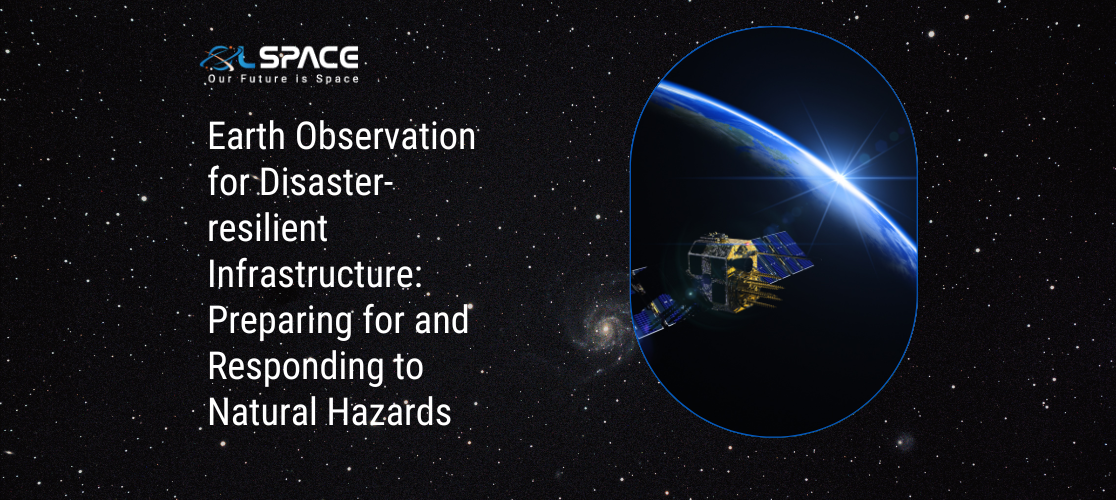30 June 2023
Earth Observation for Disaster-Resilient Infrastructure: Preparing for and Responding to Natural Hazards

Natural disasters pose significant challenges to infrastructure systems worldwide, causing widespread damage and disruption. To mitigate the impacts of such events, there is a growing need for disaster-resilient infrastructure that can withstand and respond effectively to natural hazards. Earth observation, utilizing satellite imagery and remote sensing technologies, has emerged as a powerful tool in preparing for and responding to these disasters. In this blog post, we will explore the role of earth observation in building disaster-resilient infrastructure and its potential in enhancing preparedness, response, and recovery efforts.
Early Warning Systems: Earth observation data plays a crucial role in the development and implementation of early warning systems for natural disasters. Satellites equipped with various sensors can monitor and detect changes in environmental conditions, such as rainfall patterns, temperature anomalies, and ground movement. By analyzing this data, scientists and disaster management agencies can issue timely warnings, enabling communities to take proactive measures to protect infrastructure and evacuate vulnerable areas, reducing potential loss of life and damage.
Risk Assessment and Planning: Earth observation data provides valuable insights for conducting risk assessments and planning disaster-resilient infrastructure. Satellite imagery and remote sensing technologies can assess factors such as land use, topography, and vegetation cover, aiding in identifying areas prone to specific hazards, such as floods, landslides, or earthquakes. This information helps in designing infrastructure systems that are better equipped to withstand potential risks and mitigate their impacts. It also assists in identifying suitable locations for critical infrastructure, such as hospitals and emergency shelters.
Monitoring and Early Damage Assessment: During and after a natural disaster, earth observation data enables real-time monitoring and early damage assessment of infrastructure. Satellite imagery can provide a comprehensive view of affected areas, enabling rapid identification of damaged infrastructure and potential hazards, such as bridge collapses, road blockages, or compromised utility networks. This information facilitates prompt response and resource allocation for rescue operations, emergency repairs, and the restoration of critical services.
Climate Change Adaptation: Earth observation data is instrumental in assessing the long-term impacts of climate change on infrastructure and developing strategies for climate change adaptation. Satellite-based monitoring helps track changes in weather patterns, sea-level rise, and other climate-related variables. This data allows policymakers and infrastructure planners to identify vulnerable areas, anticipate future risks, and design infrastructure that can withstand changing climatic conditions. By incorporating climate change considerations, infrastructure can be made more resilient, reducing the likelihood of damage and disruption caused by extreme weather events.
Post-Disaster Recovery and Reconstruction: Following a natural disaster, earth observation data continues to play a vital role in post-disaster recovery and reconstruction efforts. Satellite imagery can aid in assessing the extent of damage, prioritizing areas for reconstruction, and monitoring progress over time. This data supports decision-making processes by providing accurate and up-to-date information, allowing for efficient resource allocation and targeted interventions. Earth observation also enables the monitoring of environmental changes and ecosystem restoration, ensuring sustainable and resilient reconstruction practices.
Collaborative Partnerships and Data Sharing: To maximize the potential of earth observation in disaster-resilient infrastructure, collaboration and data sharing among stakeholders are crucial. Governments, international organizations, and research institutions should foster partnerships to share data, knowledge, and best practices. Open access to earth observation data encourages innovation, empowers local communities, and enables the development of innovative tools and models for infrastructure planning, preparedness, and response.
Conclusion: Earth observation plays a pivotal role in building disaster-resilient infrastructure by facilitating early warning systems, risk assessments, monitoring, and post-disaster recovery efforts. By leveraging satellite imagery and remote sensing technologies, infrastructure planners, disaster management agencies, and policymakers can make informed decisions, prioritize resources, and design infrastructure systems that can withstand natural hazards. The integration of earth observation into infrastructure planning processes contributes to more resilient, sustainable, and adaptive infrastructure, reducing the vulnerability of communities to natural disasters and enhancing their capacity to respond effectively.
